8 June 2018
Research point on drawing natural elements
Some artists adopt a similar approach to drawing other natural elements, for example the sea or the night sky. The notes encourage me to look at images by Vija Celmins to aid me in how I will attempt the first exercise of this project, namely cloud formations and tones. I will also watch a vimeo video on the subject.
Vija Celmins ( 1936 – )
I read the following of the artist, who was born in Latvia and raised in the USA: “Vija Celmins is best known for her intricate, monochromatic drawings of a select range of subjects; meticulous renderings of the surface of the ocean, the vastness of the night sky or the microscopic detail of a spider’s web. Her early object paintings and interest in scientific imagery led to her drawings and prints of seas, night skies and deserts, with their extraordinary surfaces and physical presence. Celmins takes details from images ( photos) of nature’s surfaces and skies, but removes horizons or any central point of reference. She explores the representation of three-dimensional space on a two-dimensional surface. She uses a series of graphite pencils on paper drawings and almost experiments with variations in the density and tone of graphite. I do like this idea very much! It is clear to me that this artist takes on a very slow process of drawing, but looking closely and observing every detail.
The images this artist are working from, are not from her own observations of nature, but are ‘found images’ from old magazines, books and photos. For her they are already flattened and a step removed from nature. She sees her work as lying between intimacy and distance.
To create her drawings, prints and paintings she selects and masks out a detailed area within a photograph. She then copies this using a range of grey shades to represent the different tones within the black-and-white photographs. During the 1990s she began making drawings of night skies using charcoal and an eraser. In drawings such as Night Sky #19 1999 she covers the surface of the paper using the charcoal and removes areas with the eraser, exposing areas of the paper. The white areas reveal the radiating strands of the web of stars in the night sky.



In 1966 she began to use photographs as the subjects for her works, creating what she described as ‘impossible images’, reminding us of the complexity of the simplest things. With her slow, painstaking approach, some of these works take years to complete” (National Galleries, Scotland) This is also very insightful :
‘I’m not a very confessional artist, you know. I don’t ever reveal what I’m feeling in my work, or what I think about the President. I use nature. I use found images.’
Vija Celmins (quoted in Sussler 2011, p.29)
Bibliography
National Galleries Scotland website on Vija Celmins
Tate.org.uk : Explore the art of Vija Celmins (also a video, Meet the Artist, to view as well as reading material on the artist)
Vimeo video as suggested in study material
I also looked at the work of Constable as the studied the sky and the ever-changing nature of clouds in oil sketches. He first began to study clouds in oil sketches around 1810, and his interest grew over the following two decades. “I have done a good deal of skying for I am determined to conquer all difficulties, and that among the rest.”
John Constable to Archdeacon John Fisher, letter of 23 October 1821 ( taken from ‘Experiencing Landscape”, a teachers resource, The Courtauld gallery, London)
His first pure cloud studies were made in chalk on blue paper in 1819. His best-known cloud studies date from the summers and autumns of 1820-1823. During this period he rented a house for his family near Hampstead Heath in London and there undertook several sustained campaigns of cloud studies. He usually noted the date, time and weather conditions on the versos. On the website page I referred to above of Courtald, they show an image of a study where he made two drawings, one of two he undertook the same day within less than two hours of each other, shows three banks of cumulus clouds being blown across the sky from left to right by the east wind, as indicated by the inscription. Although he evidently worked quickly, aided by the use of thin, fluid paint, he was unable to capture every detail as the clouds passed. In this case, he was able to block in the blue band of cloud in the middle ground but did not have time to finish it before it passed.
Exercise 1 Cloud formations and tone
I decide to use charcoal and my putty eraser for the first attempt at clouds outside my house. Unfortunately here on the Highveld of South Africa winter can be cloudless, with bright blue skies. On Tuesday 12 June we have clouds forming in the afternoon and I do quick study with white charcoal pencil on black paper in my A4 sketchbook. It is dry cold weather. I will follow this drawing of clouds outside as a set of exercises in the following few days and try to capture different weather patterns and times of the day. Fleeting moments and lots of fun looking at clouds above my head.

This is a bright blue sky day, but at least we have clouds today.
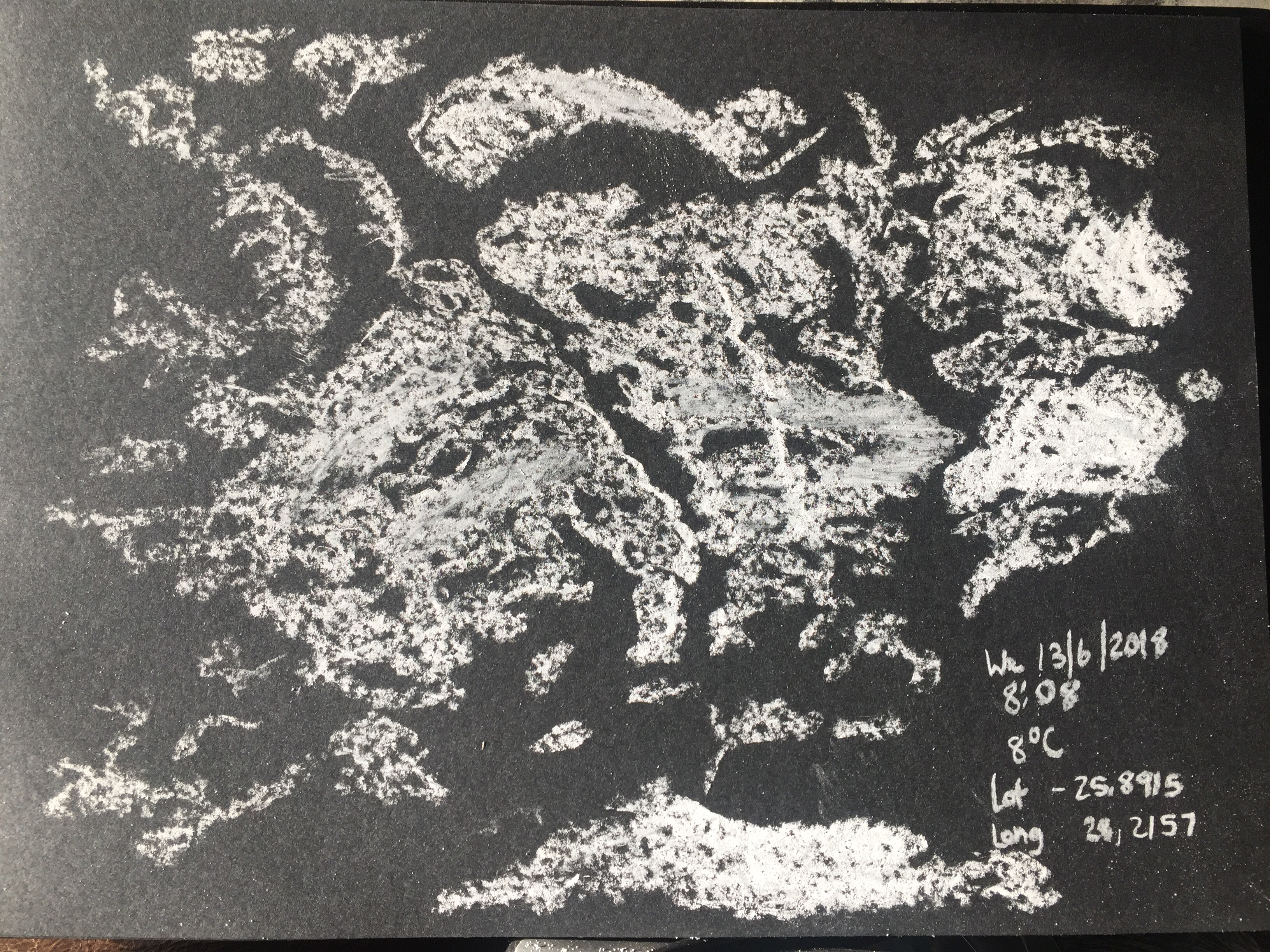
It is a chilly morning with more, but ‘thin’ clouds than the previous days.
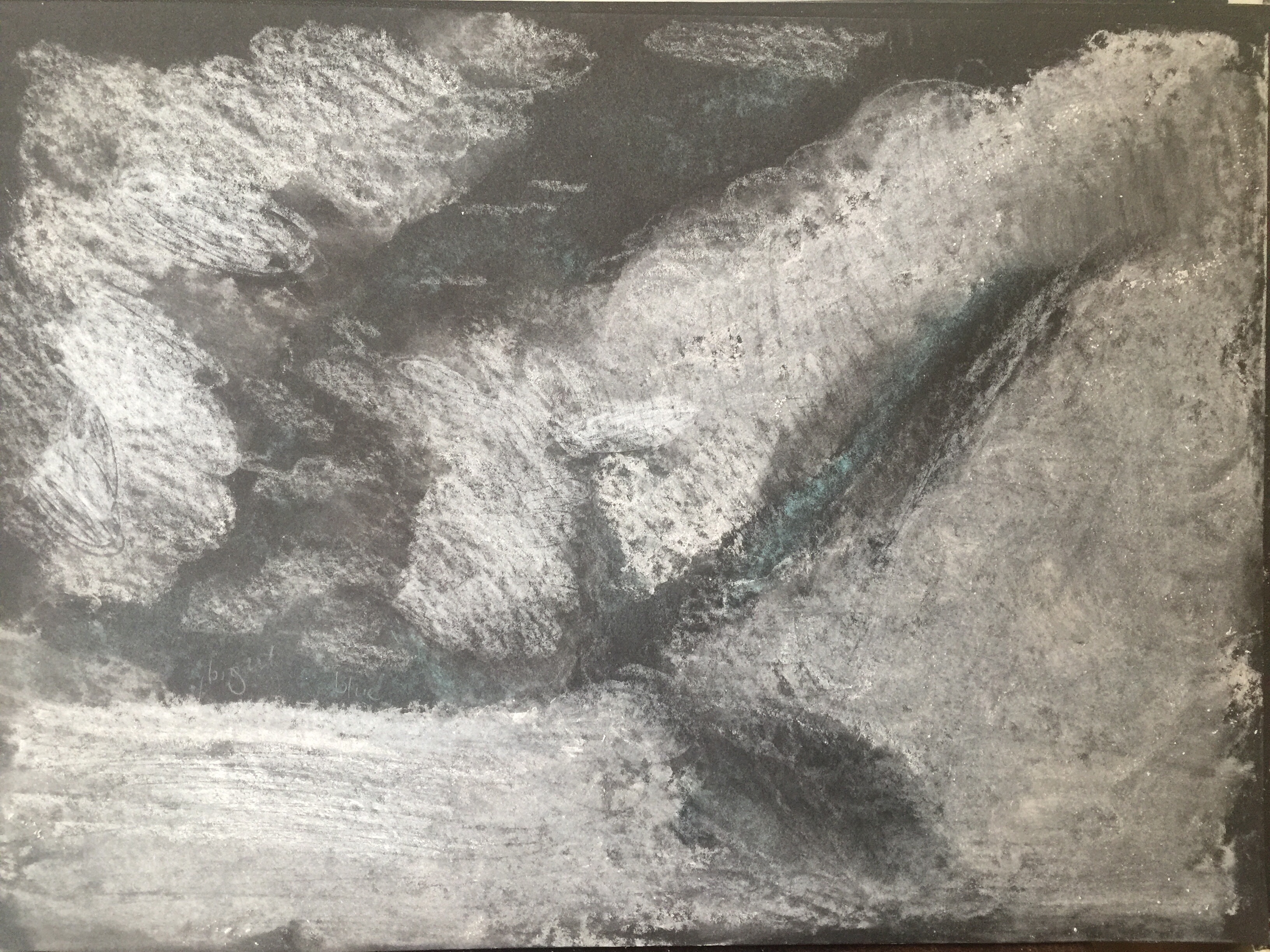
Even more clouds today. The sun is trying to shine brightly through the white areas on the left and in between the clouds we have blue skies. For the next two days we had bright blue skies and no clouds to be seen!

Soft and thin clouds moved over our house as we were having a lazy ‘Fathers Day’ meal outside – so I did what I have to do! I am finding it difficult to keep the pages smudge free and tried the fixative.
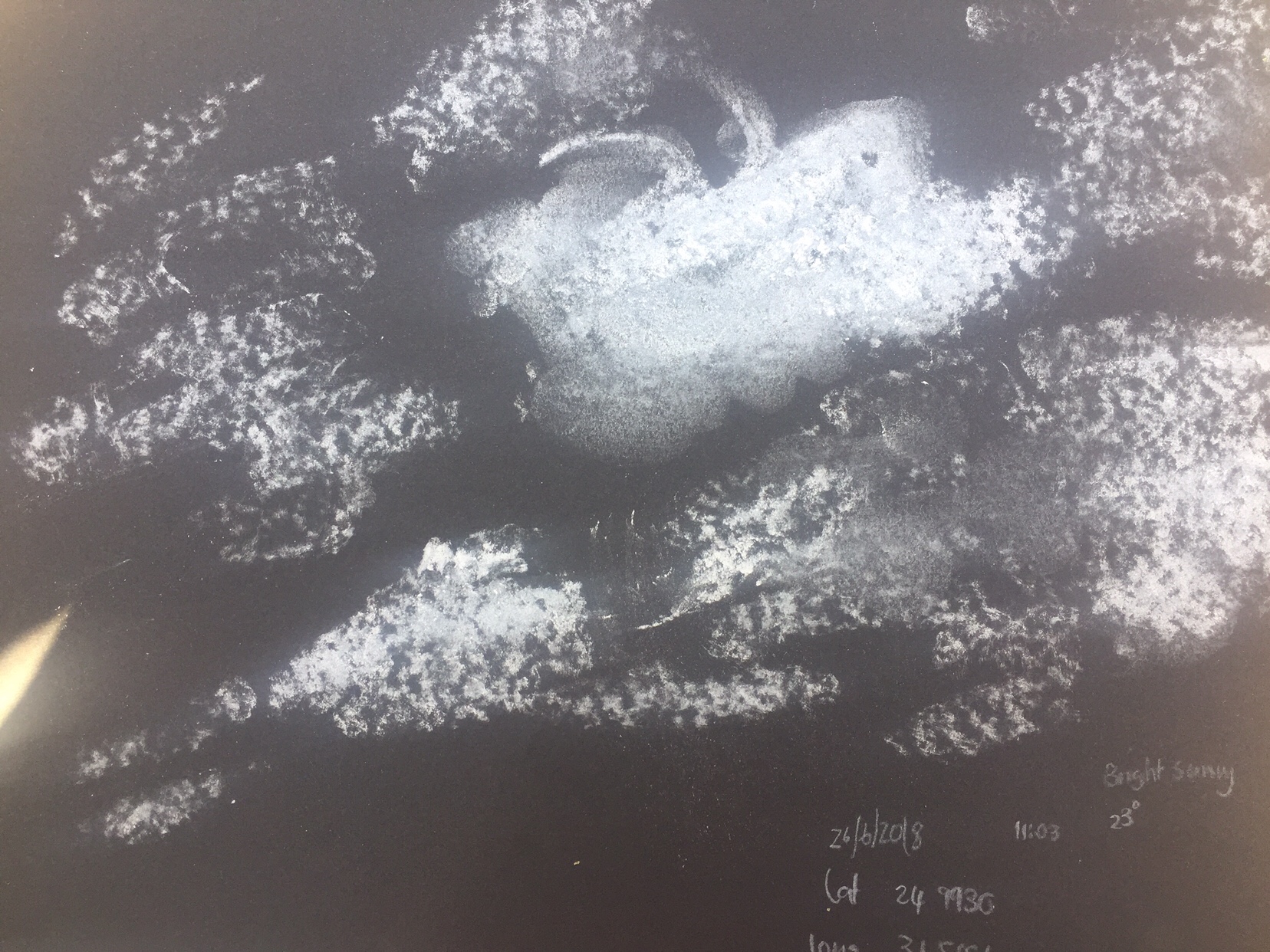
The clouds of 26 June 2018 was done in Kruger National Park and earlier the morning we had fog.

Back home – we have a few clouds early afternoon, but a bright winter’s day.


Later,the same day – some of the clouds looked really interesting.
During the week end we visited friends on a farm in the Eastern Cape Province – these clouds were drawn in the early morning and were low hanging from the eastern slopes of the Baviaans Berg – I was sitting on the veranda.


At this stage we are visiting friends on a farm in the Easter Cape, we have blue skies, but clouds in the early morning and during the afternoons. I was doing a quick sketch of aloes in the garden when these clouds came in.
Back in Gauteng by 2nd July 2018 and we are experiencing intenser winter coldness during the evenings and early morning. The minimum temperature has now dropped to -1 and 2 on average and I am seeing clouds in the sky from early afternoon around our house. I keep on the look for clouds on a daily basis.

The sun is sitting to the left of this drawing and the clouds are low hanging and bright.



Sunday is a cloudy day – clouds starting to close in on the sky and by the afternoon we had soft rains. I loved the dark sky with the white to bright white clouds moving around.

We have had rain the last few days – short showers and therefor more clouds. This is unusual rains for the Highveld, the rains are due in summer and normally goes with warm weather working up a thunderstorm and following with a rain shower.

a Starry night – within 15 minutes the sky changed and clouds covered the stars

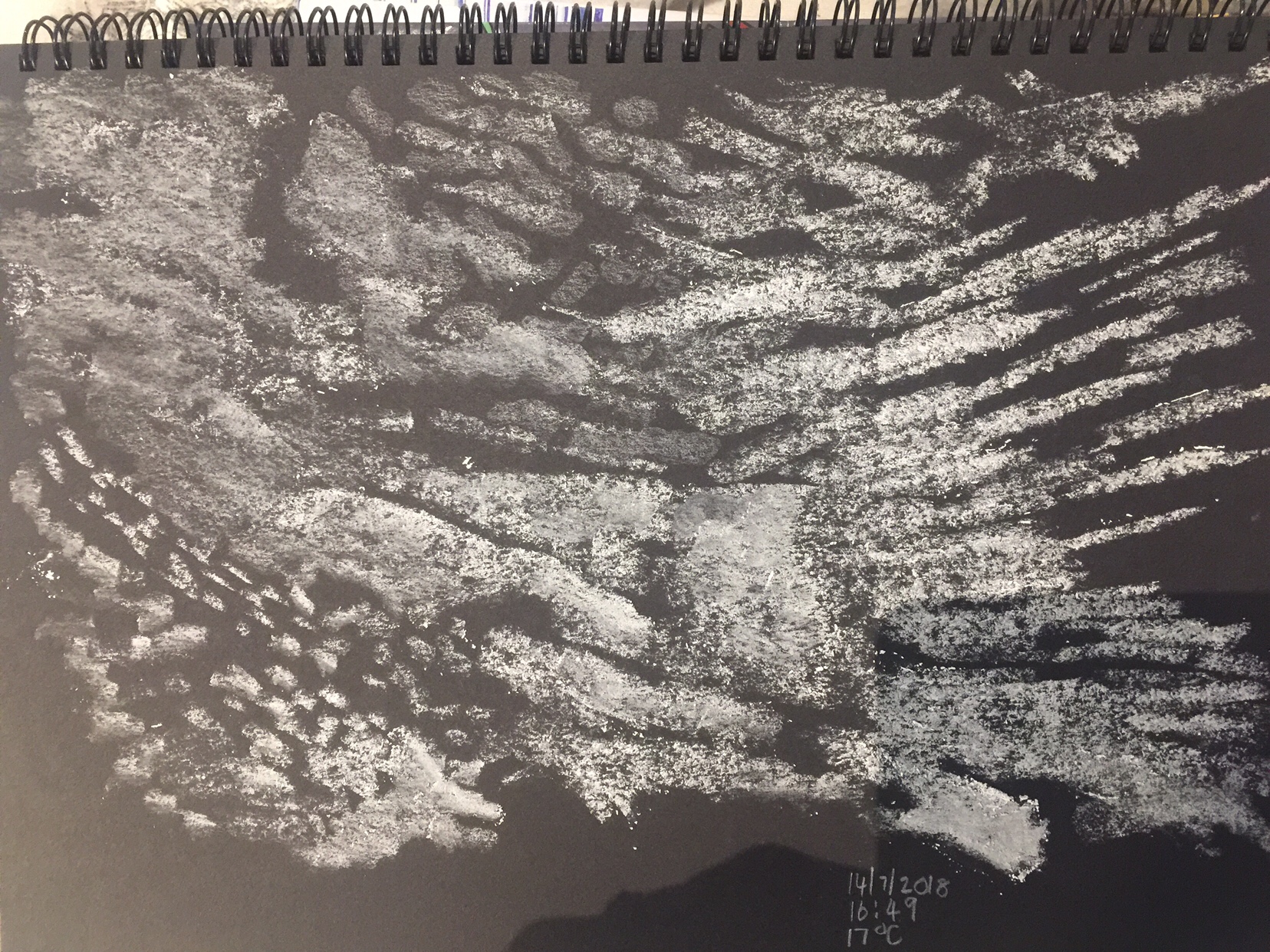
Clouds in Wellen, Belgium: My sister told me about the wonderful clouds in her part of Belgium and I asked her to send photos. I attempt a photo taken in her garden and use Hannemuhle ethcing paper which I toned with charcoal powder – I add colour with soft pastels and use my putty eraser, as well as mechanical eraser for this study of the clouds. The foreground of green trees is exciting and I decide to leave it vague and soft.

‘
I found the aerial cloudscapes painted by Georgia O’Keeffe in the 1960s and 1970s an interesting found for this part of my studies. Many of these works depict images of clouds viewed from above, suspended in blue sky, with the land below nowhere to be seen; it is the view of clouds regarded at a downward and sideways angle, as from the window of an airplane.

During this period, O’Keeffe also produced some aerial cloudscape paintings which include a view of the land below the clouds.

“It Was Blue and Green”, 1960 This painting shows a view of land seen from above through a thin layer of clouds. During this research I came upon a photo of Georgia O’Keeffe, called among trees, and the following words was so fitting for this particular part of my studies: ” Nobody sees a flower really, it is so small. We haven’t time, and to see takes time” Much of her extensive artistic productions became focused on diverse elements of the natural world: animal bones, shells, desert, sky, and most frequently, flowers. She often enlarged flowers, making a single flower dominate the entire pictorial space and hereby explore the beauty of nature and emphasize formal qualities such as shape, colour, and line. Another quote to ponder upon:” I had to create an equivalent for what I felt about what I was looking at – not copy it. ”
– Georgia O’Keeffe
I came upon the work of a contemporary visual aerial artist, Jorge Rivas. He is from Venezuela.


Exercise 2 : Sketchbook walk
Make four sketches during your walk and observe the
- time, weather conditions and direction of light and shadow,
- main point of interest such as a building, gate or group of trees
- division of space into foreground, middle ground and background
- pattern and textures, repetition of large and small shapes, tonal values, etc, across the scene.

This is a Sweet thorn tree, marked alongside the walking areas in our estate. in the background there are houses and what I particularly like about this view, is that the road curves and the tree is almost discovered as you walk. The leaves are minute, with between 5 – 20 pair per pinna, and a leaflet has 2 -6 pairs of pinna. It is a medium sized tree and the flat pods are lying around the tree, which I also picked up as part of my found objects and walkabout. These trees are covered in bright yellow head in Spring and Summer. It was late afternoon and the sun was shining brightly from the West and casting lovely shadows onto the pathway and the houses in the distance. I tried to show the branches with green leaves in the foreground and the houses in the background.
The next place I quickly stopped is my grandson’s favourite tree. He believes the leaves will grow again. This is a dead tree behind a seating area, in between the lovely natural grasses and veld

This is also late afternoon and the drawing was done really quick. I am contemplating to go back and re visited Zen’s tree. The bench, made of sleepers is terribly badly drawn. I went back on Sunday late afternoon to give the drawing another try. It was quiet around the walking way so I could spend at least 10 minutes drawing Zen’s tree again. It is still a bright sunny afternoon. This time the sun was going down in the West. I used my A5 black paper sketch pad and chalk

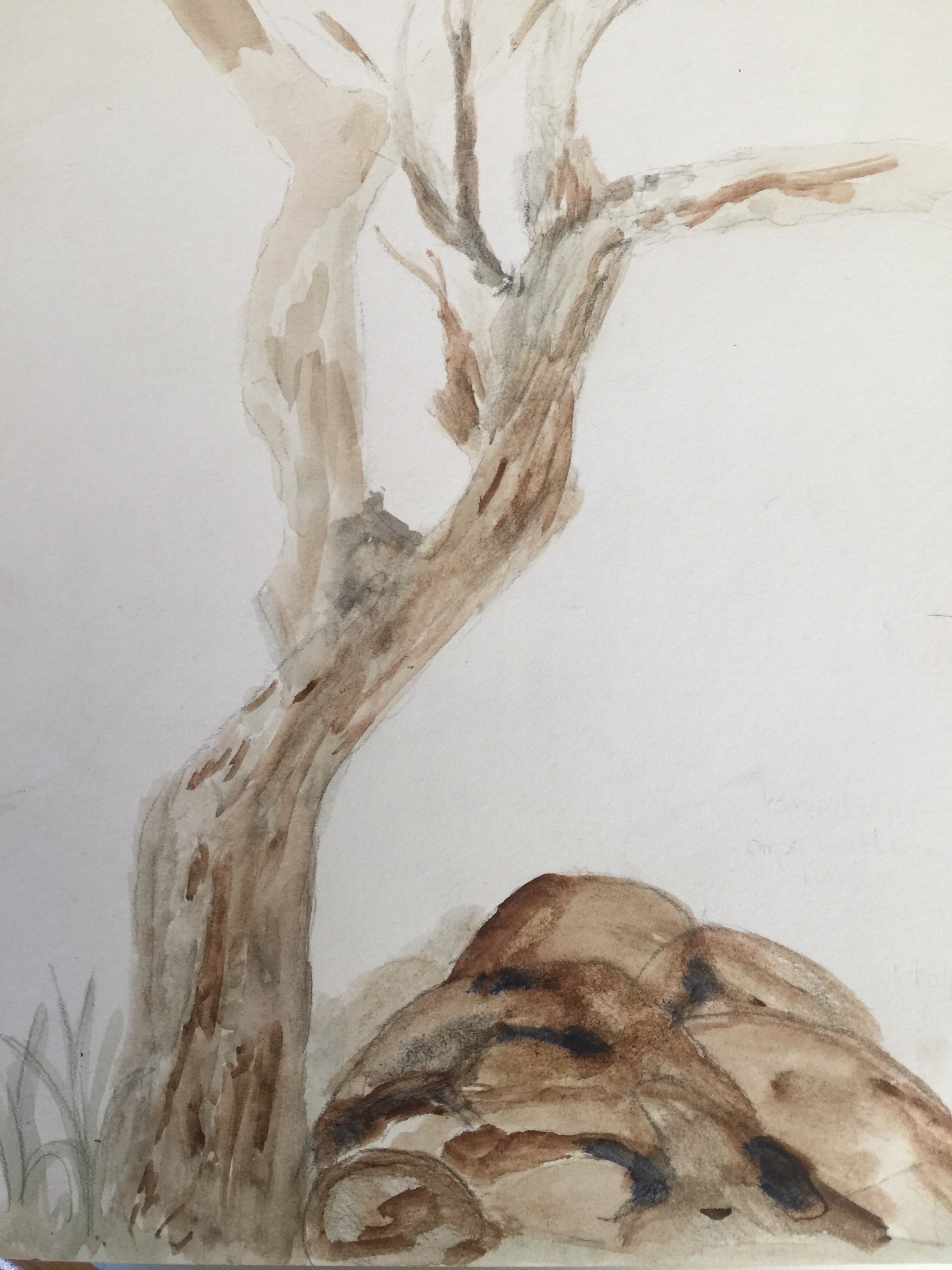
Exercise 3 : 360′ studies of an expansive landscape
Whilst in the Kruger National Park, I had time to sit and draw outside the tent I was staying in. This is riverine forest and it is common to see wild life and lots of birds.
I was fascinated by the KnobThorn tree that was almost lying down and the growth of snake shaped plant that encroached the trees.

One view was really lovely with this rope like branches growing around the tree. I did a quick drawing on black paper with pastel pencils. At home I read that the other thorns surrounding me, were Delagoa Thorns and this vegetation is where one should be on the look out for White Rhinoceros. ( This was my reason for being in this area!) The ecozone is called Ecca Shales and of the oldest granite/gneis is found here, between 3500 and 200 million years. The short grass in this area is particularly short and tasty.

Above – I tried to play with the tree stems and negative space, early morning trees.
Some found objects: dried fruits of the Marula tree



I used some Aloe Vera Gel at home, mixed it with water and added it to the drawing.

The gel gave a soft oily like consistency as being moved onto the drawing with a paintbrush. I overworked some areas, but would work with this again.
Research point: Looking at historic and contemporary artists who work in series with the landscape.
Looking at the work of Peter Doig, I researched his series on the paintings of Le Corbusier’s classic modernist apartment block offer a mysterious Utopia: cosmopolitan dream architecture

In the above scene he cropped the image to exclude ground or sky. It leaves the viewer with the presence of a fleeting moment, and the scene has no physical orientation or weight. In a conversation with Artspace, Feb 2018, Doig talks about visiting the Le Corbusier building for the first time, he never dreamed that he would end up painting it. “I went for a walk in the woods on one visit, and as I was walking back I suddenly saw the building anew. I had no desire to paint it on its own, but seeing it through the trees, that is when I found it striking.” Dubbed as an ideal living environment when they were unveiled in 1961, these apartments soon lapsed into disuse and disrepair, becoming derelict by 1973 before being subsequently renovated for habitation. Doig entered the building alongside a group of architects affiliated with its redesign in the 1990s, using a handheld video camera to record the disorientating approach to the building through the uncultivated surrounding woods. I could see more of this series on a Tate video of the artists during an exhibition at Tate Brittian, Feb – April 2008. I listened to a lecture by Doig ( Slade Contemporary Art Lecture series , UCL Slade, 4 July 2016) Where he showed photos of this building and said he also made video footage. He made still of some of this footage and this gave him these images of the verticality of the trees as they broke the view of the building and gave a feeling of motion. He was quoted as saying “I’m not trying to make paintings look like photos. I want to make paintings using photos as a reference, the way painters did when photography was first invented”. The artist’s overall theme explores the relationship between man and his environment. His paintings starts with source material and or photographs and many times he does etchings in the preliminary process of his work. It also seems that this artist has the ability to get the viewer to view his work from an almost panoramic view, as well as a close up view. A conversation (video) with Jasper Sharp at Kunshistorisches Museum, Vienna brought me to also view the work of Pieter Bruegel, which could be seen as very influential in the work of Doig.
Pieter Bruegel (1525 – 1569)
He was a Flemish painter of landscapes with interesting happenings and witty scenes of pheasants within daily scenes in the country.
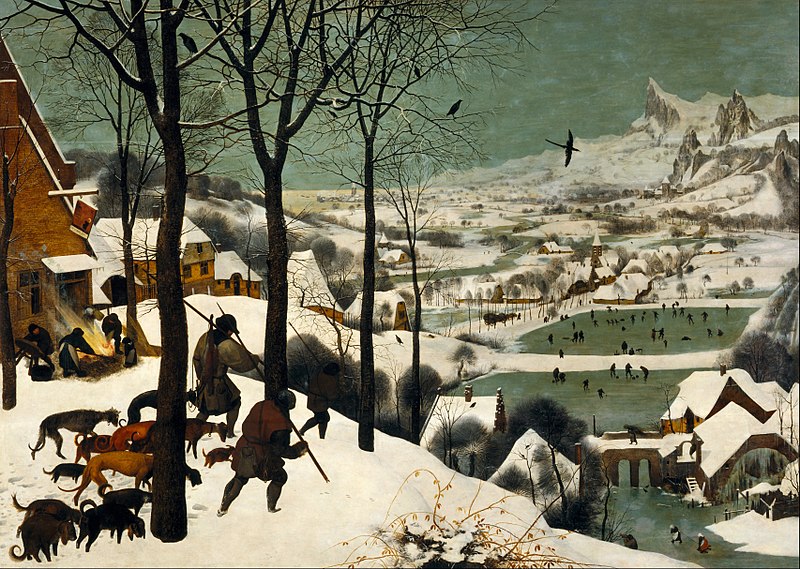
It seems this is part of a series of works, of which 5 remained and shows different times of the year. It demonstrates both the artist’s interest in capturing the changing seasons and his sense of perspective and depth.
The work of John Virtue is solely in black and white. His paintings are executed on canvas and he uses white acrylic paint, black ink and shellac, although he also does the same on Arches paper. It seems his work reflects his local landscape. I looked at his works of “The Sea” and read that he lives near the sea and regularly walk and draws in the North Norfolk beach area – it is a 4.4 miles x 2 walk he takes . His sketchbooks form part, like recordings of his process to work on very large paintings as well as smaller ones on Arches paper. But no matter how fast an experienced hand can draw, the sea is strangely cruel to artists. Virtue points out: “It changes faster than you speak. It changes all the time, not just from day to day but from second to second.” But the philosophical painter is quite content with this. His sea paintings are really mesmerising and the fact that they are not the the colour blue/green as the true sea – it could also be just an abstract painting. I love how he uses the ever changing views and movement of the waves and water. I squinted my eyes when looking at the paintings, and it felt as looking at the beach on a dark evening. I really love these very awesome tonal and atmospheric works. Virtue does not make use of a camera of photo images – he uses his fast sketches and drawings.

Map paintings by Uwe Walther, born in Germany in 1965, caught my eye. He uses topographical maps to create alternative landscapes and environments.


Last, but not least, I looked at the work of NIcholas Herbert, and was completely bowled out by these works. I almost felt overwhelmed by what I learnt in this research point up to now! ! This artist uses colour and medium to create atmosphere which is loaded with tenderness and respectful to the beauty of the landscape.
I think he is the “soft” version of Monet!

It left me with my own memories of the Amalfi Coast, visited in July 2011 – a photo is just so impersonal.
References;
Lemonedes, Heather, Lynn Federle Orr and David Steel, Monet in Normandy, Rizzoli International Publications, 2006, ISBN 0-8478-2842-5
Tate